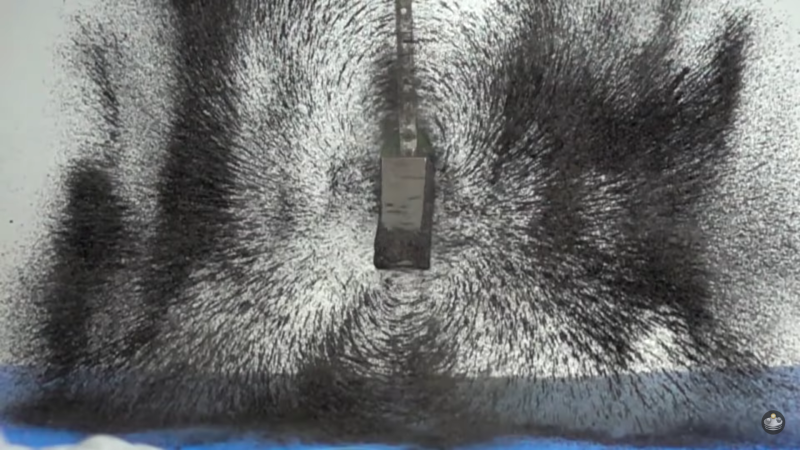If you need help visualizing magnetic fields, these slow-motion video captures should educate or captivate you. Flux lines are difficult to describe in words, because magnet shape and strength play a part. It might thus be difficult to visualize what is happening with a conical magnet, for a person used to a bar magnet. We should advise you before you watch the video below the break, if you are repelled by the sight of magnetite sand clogging a bare magnet then flying on the floor, this is your only warning.
The technique and equipment are simple and shown in the video. A layer of black sand is spread on a piece of tense plastic to make something like a dirty trampoline, and a neodymium magnet is dropped in the middle. The bouncing action launches the sand and magnet simultaneously so they are hanging in the air and the particles can move with little more than air resistance.
These videos were all taken with a single camera and a single magnet. Multiple cameras would yield 3D visuals, and the intertwining fields of multiple magnets can be beautiful. Perhaps a helix of spherical magnets? What do you have lying around the hosue? In a twist, we can use magnets to simulate gas atoms and trick them into performing unusual feats.
Via Gizmodo. Thank you for the tip, Itay.
















He’ll never get the iron particles from the magnet *ever*.
Pull them off with a stronger magnet?
Maybe use an electromagnet? Pull the iron off with the electromagnet then shut the electromagnet off?
Heat?
Heat is deadly for magnets…
Weller Magnastat?
I was thinking, from the first attempt : how do they clean it ?
But as they sell those fantastic magnets, they can throw ’em away after each try, dommage, as we say in french.
Anyway, it’s beauty full and very simple idea, they have a lot of amazing videos of “things to have fun with magnets” ;o), I’m a good customer, a bunch of assorted magnet is a great gift for children of all ages (old enough not to eat it).
“dommage, as we say in french.”
Everything sounds better if you say it in French. “Voulez-vous sortir les poubelles?” Or perhaps, “Voulez-vous jeter ces magnetes par la fenêtre?”
You may try with a pointy tip of magnetic metal, such as a needle. Approach the tip to the particles, near the surface of the magnet and they should be attracted to it, leaving the latter. The magnetic field and its gradient are more intense at the tip because of its small radius compared to the curvature of the magnet’s surface. The same principle behind pointy bits and ionisation or corona discharge with electric fields in this case.
Masking tape
love it!
Acid should do it…hydrochloric I would guess.
Try to wipe off as much as you can then go at it with another magnet attached to a razer blade. Some fragments should be able to gather above the blade and once full it can be removed from the big magnet and cleaned, then repeat until finished. …could take a while. :-)
It is a fun video but a 4 euro/dollar/pound “magnetic field viewing film” (isolated painted nickel flakes suspended in oil) will be much easier to clean up.
The same channel even have a video of it https://www.youtube.com/watch?v=yBSaPyLV8Vs
Wow, what an amazingly simple Idea!
Wish the camera had been rotated about Z in real time…to capture the 3D nature of the fields, which is really what would separate this idea from filings on a sheet of paper.
The Hackaday article on visualizing magnetic fields with black sand and neodymium magnets is quite fascinating. For those interested in exploring magnetic fields further, the “Thuban Lodestar” app on the Play Store is a great tool. It allows you to measure magnetic fields using the magnetometer built into your smartphone. This app supports various sensors and offers a user-friendly interface for data visualization, making it a handy addition for anyone keen on studying magnetic fields. Check it out to enhance your experiments and observations.
https://play.google.com/store/apps/details?id=com.lugatek.thubanlodestar